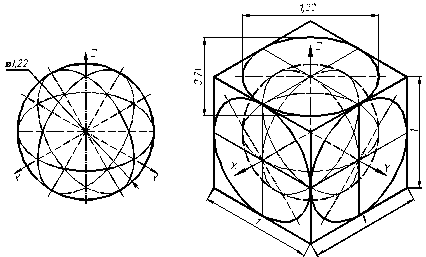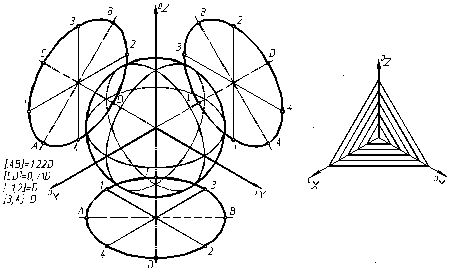RECTANGULAR ISOMETRIC PROJECTION
Izometry is a axonometric projection with the equal indexes of distortion for all three axes. Figure 3.3,а shows a sphere in a rectangular isometric projection the diameter of which equals a metage. A corner between axes is 120°. Place this sphere into a cube ribs of which, also equal to the direction of axonometric axes (see fig. 3.3,b). Project a sphere on the verge of cube. Such type of planning is called American. The projections of the sphere on the verge of a cube are smaller in size (disfigured). That segment of coordinate ax long 1 mm in rectangular izometry will be represented the segment of axonometric ax long 0,82 mm. Correlation 1 / 0,82=1,22 times determines a coefficient down-scaling on which we increase the sphere (see figure 3.3,c). Now the projections of the sphere as ellipses are inscribed in the verge of a cube (see figure 3.3,d). The major ax of ellipse makes 1,22 diameter – D of a projection circle of the sphere (equator, frontal meridian, type meridian), and minor axis – 0,71 diameter. Place a sphere in the usual (europian) first angle projection method. Figure 3.3,e shows the correlation for determination of length of cuttings-off of major [AB] and minor [CD] axes of ellipses. Sizes of cuttings-off [1, 2] and [3, 4] equal the diameter of projected circle of a sphere, and in general case the diameter of a cylinder or a hole on a figure. While making of quaternary cuts in rectangular izometry follow to the rules resulted of hatching as shown in fig.3.3,f. Stroke lines are drawn parallell to the axonometric axes.

а) b)

c) d)

e) f)
Дата добавления: 2016-07-18; просмотров: 1565;











